Say Goodbye To Frozen Toes
Finally, winter cycling footwear to keep toes toasty: Bonrager’s new winter boots.
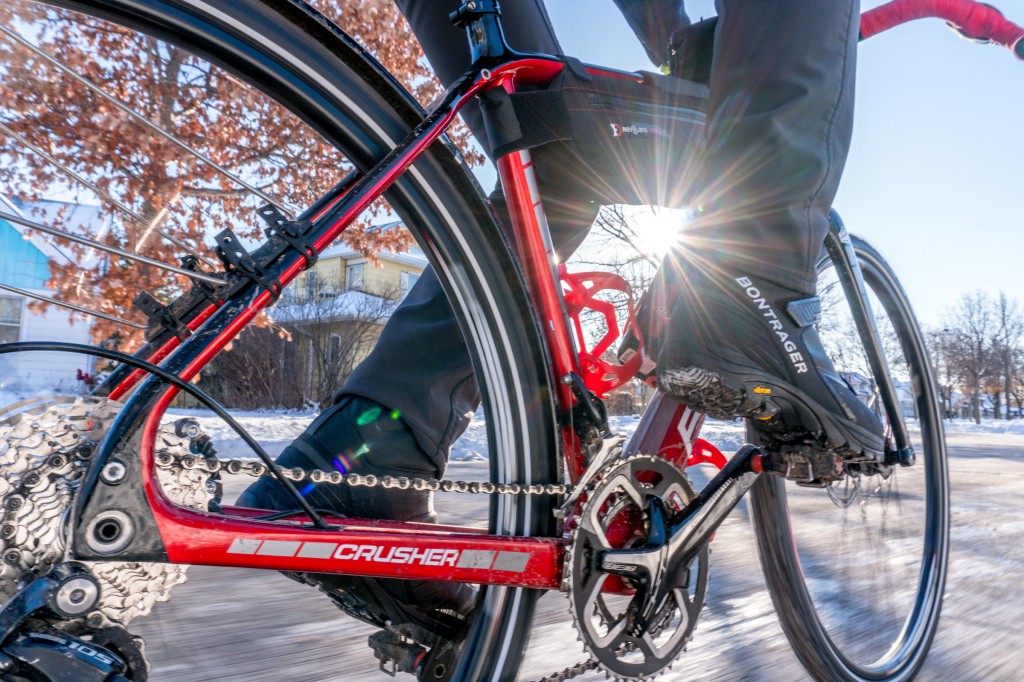
Christmas came early and my bike and I both got new winter sneakers this year. 45NRTH Gravadal studded tires (love them, review coming soon) for my Fyxation Crusher and Bontrager Old Man Winter boots for me!
I think I have finally found the holy grail of winter cycling footwear in Bontrager’s Old Man Winter boots. Over the last decade I have purchased pretty much every brand and model of winter cycling boots. I found serious fault with pretty much all of them and ended up selling the lot at a big loss at our Bike Bazaar swap meet the following year. Below is a list of all the boots from worst to best (note a number of these boots I had were several models old. There may have been improvements in the current models):
- Louis Garneau (~10 years ago): Too narrow and my feet got cold even in mild winter temps (older pair of boots, not the current model)
- 45NRTH Japanther (2016 model): These really hurt my ankles, even after a couple hundred miles of break-in. The other major complaint was the zippers were very hard to close and they constantly unzipped while riding.
- Northwave Celsius (~8 years ago): Warmer than either of the other boots above, but they were not waterproof and my feet still got cold if it was below 20 degrees Fahrenheit.
- Lake MX 303 (~4 years ago): These were very comfortable and reasonably warm, but not waterproof at all, even after I tried using different waterproofing treatments on the leather.
- 2016 45NRTH Wölvhammers: Very nice boots, but the Bontrager OMW boots edge them out because because the Wölvhammers don’t have removable liners. They are comfy, about as warm as the Bontragers, and I like these enough that I am going to keep the pair I bought a couple months ago as a second pair and put studs in the soles. I already have studded tires, but when you get off the bike on ice, it is nice to have them on your feet too!
While I have only had the Bontrager Old Man Winter boots for a couple of weeks now, thanks to the good snow and single digit- to below-zero temperatures we have had lately, they have seen a lot of use. Bottom line, I flat-out love these boots and highly recommend them. On my most recent hour-long ride in ten-degree windy weather my feet were perfectly comfortable. The temperature was -1 degree F for the two-hour photo shoot for this review. My feet stayed warm even though much of that time was standing around on concrete, not generating heat riding.
The feature I like the best about them, and what sets them apart from any other cycling specific winter boot I am aware of, is the insulated booties are removable. Sorel figured out how important it is to be able to remove boot liners 50-plus years ago. This allows you to swap liners made for different temperature ranges, but more importantly, it allows your boots to dry quickly after use. The other bonus of removable liners is they can be worn like slippers when you get done riding. I wear mine around the office when I get to work. I have not taken them on a winter bikepacking camping trip yet, but I look forward to wearing them inside my tent rather than just socks.
Because it’s so easy to remove the liners, I suggest you get a pair of boots that are at least one size up from your normal cycling shoe. If you plan on doing really long rides like the Tuscobia Ultra or the Arrowhead 135, you might want to go up two sizes or even three and try fitting in heavier liners from a pair of Sorel boots.
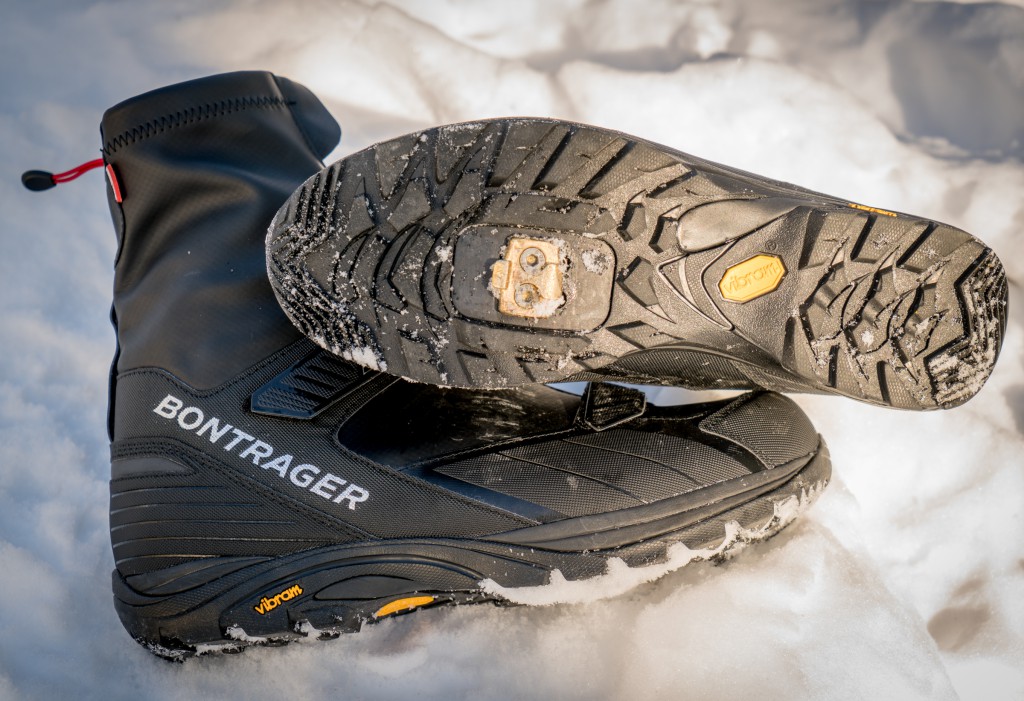
The soles are grippy, stiff enough and best of all, the cleats are recessed enough so they don’t click when you want.
The Bontrager OMW boots have a number of other features I like, beginning with the simple zipper up the center and a couple velcro straps. Personally, I don’t need a fancy Boa lacing or ratchets to dial in the fit for winter boots. The laces on the Bontrager liners and the two, simple velcro straps work perfectly fine, and I kind of dig how they look a bit like old school galoshes I had when I was a kid.
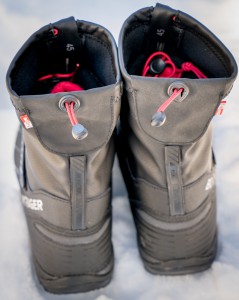
The cinch top boots keep out the snow and draft if you wear them with tights and the little straps above the heels fit optional Bontrager Ember lights.
I also like the pull-on loops on the liners and how well they fit inside the boot without sliding. The boots allow you to cinch up the cuffs at the top to keep snow from getting in if you wear tights, but my go-to winter bottoms are Swrve Softshell Trousers, which fit over the boots snug enough to keep out the snow and rain. The covers over the zipper, loops to clip Bontrager Ember lights to the heels, show a further attention to detail.
The Vibram soles are grippy and get big bonus points for being tall enough so the cleats don’t click when walking. You can wear these inside without fear of damaging hardwood or vinyl floors. Bontrager rates the soles as a 6 out of 14 on their stiffness scale. I can say they are plenty stiff for riding but also very comfortable to walk in.
Finally, they are pretty light for winter boots. Definitely lighter than my 45NRTH Wölvhammers. My pair of size 45 boots weigh 1,275 grams on our mail scale at the Bike Fed office. Bontrager puts a $299 MSRP on these boots, which is less than the Wölvhammers at $325 MSRP, and I like the OMWs better. Of course neither of these boots is inexpensive, but you get what you pay for with them. If these are outside your price range, you can try waiting until they go on sale at the end of the season, but you might not find your size. Of course you can always just wear your regular winter walking boots (my current favorites are Keen Summit County) and use platform pedals too.
Bike Czar
-
Join a Bike Ride Under the Polish Moon
 Jun 1st, 2018 by Dave Schlabowske
Jun 1st, 2018 by Dave Schlabowske
-
9 Reasons to Join National Bike Challenge
 May 4th, 2018 by Dave Schlabowske
May 4th, 2018 by Dave Schlabowske
-
Biking Through the Mindoro Cut
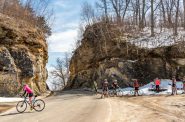 Apr 27th, 2018 by Dave Schlabowske
Apr 27th, 2018 by Dave Schlabowske


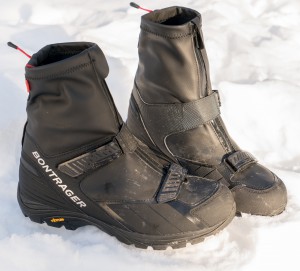



















Very helpful article with lots of specifics. Thank you! Will reference when buying boots.